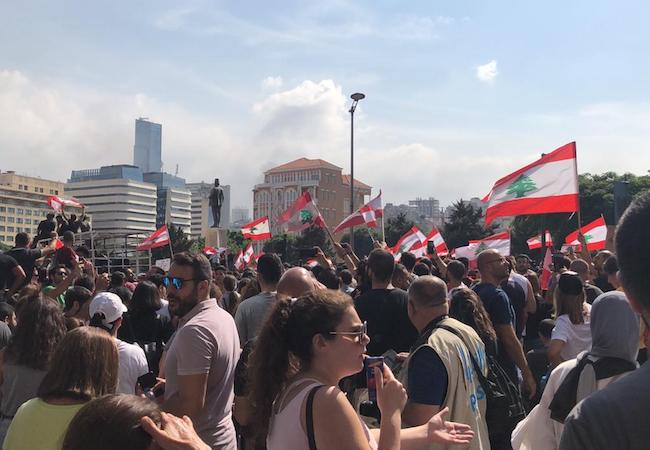Lebanese protest unity triumphs decades of sectarian division

By Younes Mahmoudieh
Selective media coverage in the West often results in a fragmented and inconsistent understanding of events in the Middle East. The recent protests in Lebanon are of no exception. Though the growing popular movement has come as a surprise to media outlets in the United States who rather simplistically label the protests as “spontaneous rioting” over recently introduced taxes, the reality in Lebanon is much more complex. Decades of governmental mismanagement and corruption have resulted in massive popular frustration and unified an often divided country that has been rocked by sectarian tensions. The Lebanese discontent has manifested across sectarian lines while attracting broad support from diverse groups. The protests seem to be anti-establishment in nature and reflect public frustration over the country’s fractured political system. The Lebanese government has proven itself incapable of being able to resolve the nation’s dire economic crisis. Lebanon’s future is to be decided in the coming days. How the Lebanese government responds to the riots will have lasting implications in Lebanon and will potentially have broader geopolitical consequences in the Middle East.
The Lebanese Political System
Unity and organization are necessary components to any long term planning in Lebanon. The current economic crisis is the direct result of a fractured system that has been incapable of establishing any power sharing agreement that can effectively unify the country and manage Lebanon’s domestic affairs independent of any foreign influence or control.
The National Pact of 1943 (an unwritten gentlemen’s agreement between the Maronite Christian President Bishara al-Khouri and his Sunni Muslim Prime Minister Riyadh al-Solh) established a unique political formula that allocated the country’s governmental positions in respect to religious community representation. “It was agreed that the President of the Republic was to be a Maronite Christian, the Prime Minister a Sunni Muslim, and the Speaker of Parliament a Shia Muslim. Other lower political posts were also assigned according to this formula. Representation in parliament was set according to a ratio of 6:5 in favor of the Christians. The Taif Agreement of 1989, which officially ended the long-running civil war, reasserted the confessional formula but changed parliamentary representation to a 50:50 Christian/Muslim ratio.”[1]
This inherently flawed political system has resulted in a detrimental rivalry between the country’s religious communities fostering increased hostility across demographic lines. Lebanon hosts an extremely diverse population and is home to a multitude of ethnic and religious minorities. The constitutional competition created by this pact pitted these populations against one another. The country’s Christian, Sunni, and Shia communities are often seen competing and vying for power and leverage which has only led to deadlock, corruption, stagnation, and ineffective management. Interestingly enough, the consequence of this futile sectarian competition is the current unified discontent that has gained broad support across the country’s entire population. All of Lebanon is now united in its frustration over the country’s current predicament. Division is to blame for Lebanon’s political incompetence. Unified discontent is the result.
Meddlesome Neighbors
The Lebanese Civil War (lasting from 1975-1990) precipitated regional intervention into Lebanon which has directly influenced the management of the country and has not allowed for any independence or self reliance to take shape. Ever since the country’s warring factions invited outside powers to take sides and sponsor various efforts to take control, the country has been divided by its neighbors; each carving out their own sphere of influence. Iran, Syria, Saudi Arabia, and Israel have each played significant roles in Lebanon which has prevented any semblance of autonomy or self determination to take hold. Foreign interference in Lebanon has always prevented independent leadership from succeeding.
The creation of Hezbollah in 1985 effectively countered the Israeli threat to Lebanon’s border but changed the dynamics of the country’s domestic politics forever. The popular militant group, which also serves as a Shia political party, is often perceived as an Iranian proxy (the group was initially trained and organized by the Iranian Revolutionary Guards). Hezbollah enjoys broad support amongst Lebanon’s Shia and Christian populations as well as funding from Iran and Syria. As protests continue Hassan Nasrallah, the group’s leader, has spoken out sympathetically and called for government action but has rejected calls for the cabinet’s resignation as “a waste of time” which has disappointed many.[2] The party has immense influence in the country but faces a striking dilemma; choosing between the government establishment (which it is a part of) or appeasing the protesting masses. It is unclear how long the group can afford clinging to a middle line.
Decades of Mismanagement
The Lebanese economic crisis has been years in the making. The recently introduced taxes happened to be the spark to ignite massive protests. Lebanon currently has the world’s third highest debt-to-GDP ratio: 150%.[3] 37% of the country’s young population (under the age of 35) is unemployed.[4] Prime Minister Saad Hariri initially gave lawmakers 72 hours to introduce and support economic reforms meant to ease the crisis. Though these reforms are meant to temporarily placate the population and soothe the Lebanese turmoil, they are by no means a permanent solution. The problem is systemic. Though calls for a revolution may be dismissed as exaggerated, the current crisis is by no means trivial. A lasting resolution to Lebanon’s economic and political system is integral for the country’s independence and long term stability. Economic growth and progress is only possible through effective, unified management which has been made almost impossible by the country’s current political structure. Prime Minister Hariri’s desperate attempts to secure “$11 billion in foreign aid from international lenders” can not replace an absence of domestic foresight and vision or fix a political system plagued with corruption.[5]
Recent coverage of Hariri’s romantic relationship with a South African model and payment of $16 million in extravagant gifts while the country suffers with massive debt and unemployment has only aggravated and provoked the masses. The prime minister is currently married with children. “His business and political empires have fallen on hard times, depriving many employees of their pay. His family’s construction conglomerate, Saudi Oger, ceased operations in 2017, and his media outlets have struggled to pay salaries.”[6] The revelations about Hariri’s bank transfers to model, Candice van der Merwe, come at a bad time as the government announced plans to declare an “economic state of emergency.”
The Current Protests
Hundreds of thousands of people continue to fill the streets of Beirut demanding the government’s resignation while expressing frustration over the country’s economic crisis and systemic corruption. Initially triggered by government inaction following the worst wildfires Lebanon’s experienced in decades as well as the simultaneous introduction of new taxes (including a tax on the popular messaging app WhatsApp which has since been removed), the protests quickly evolved and grew.
The dancing and singing protests in Lebanon have quickly gained international media coverage as the world watches with hesitation. The protestors have made few organized demands other than the resignation of the current government; a demand swiftly dismissed by the country’s elite. The government has passed swift economic reforms, but popular frustration has not subsided. “Among the reforms is a 50-percent reduction in salary for former and current politicians and ministers; the abolishment of the Ministry of Information and…the establishment of an anti-corruption panel.”[7] The protests, however, show no sign of dissipating. There is no quick solution.
Thankfully, Violence has been avoided thus far. An unstable Lebanon would pose a serious threat for the region. A lasting, domestic resolution is crucial. Foreign interference does not work. The people of Lebanon are tired of waiting. They deserve a better future.
References
[1] “USIPeace Briefing.” Lebanon’s Confessionalism: Problems and Prospects: USIPeace Briefing: U.S. Institute of Peace, 30 Mar. 2006, web.archive.org/web/20080709034419/http://www.usip.org/pubs/usipeace_briefings/2006/0330_lebanon_confessionalism.html.
[2] “Lebanon’s Nasrallah Backs Government amid Raging Protests.” Lebanon News | Al Jazeera, Al Jazeera, 19 Oct. 2019, www.aljazeera.com/news/2019/10/lebanon-nasrallah-backs-government-raging-protests-191019103517160.html.
[3] Marc Jones. “The Dire Debt Numbers Facing Lebanon’s New Government.” Reuters, Thomson Reuters, 4 Feb. 2019, uk.reuters.com/article/lebanon-bonds/the-dire-debt-numbers-facing-lebanons-new-government-idUKL5N1ZW62S.
[4] Ellen Francis. “Protests Sweep Lebanon as Fury at Ruling Elite Grows over Economic Corruption.” Reuters, Thomson Reuters, 19 Oct. 2019, www.reuters.com/article/us-lebanon-economy-protests/protests-sweep-lebanon-as-fury-at-ruling-elite-grows-over-economic-corruption-idUSKBN1WX0Q8.
[5] Firas Maksad. “Lebanon’s Year of Fire.” Foreign Policy, Foreign Policy, 22 Oct. 2019, foreignpolicy.com/2019/10/21/lebanon-sectarian-protests-forest-fires-self-immolation/.
[6] Ben Hubbarb. “Lebanon’s Prime Minister Gave $16 Million to South African Model.” The New York Times, The New York Times, 30 Sept. 2019, www.nytimes.com/2019/09/30/world/middleeast/lebanon-hariri-model.html.
[7] “Lebanon Protests: All the Latest Updates.” News | Al Jazeera, Al Jazeera, 22 Oct. 2019, www.aljazeera.com/news/2019/10/lebanon-protests-latest-updates-191022065629885.html.
Younes Mahmoudieh is a researcher on Iran-West relations at UCLA under the guidance of Ambassador Mousavian. His articles have appeared extensively in Iranian media as well including but not limited to Hamshahri Newspaper, Eghtesad news, Payvand News, Gooya News, and Khabaronline. His research “The Nuclear Deal: A Crossroad or Deadlock in Relations with Iran” was recently published by the International Studies Journal.








